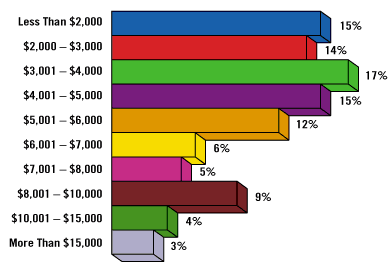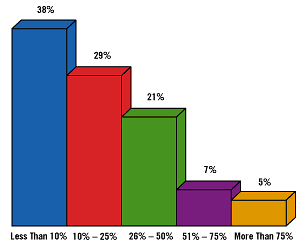
One clever HVACR contractor paints one side of his service vehicles green and other side white. He said that people constantly comment on how many trucks his company has on the road, even though his fleet has only a handful of vehicles.

Contractors recently interviewed by The News reflected fleets of various sizes. Charles Rauch of Valley Heating & Air Conditioning Inc., McMurray, PA, said his company has three service vehicles, while Scott Pargin of YPS, Austin, TX (a former “Best Contractor to Work For” contest winner), has 50 service vehicles on the road.
Rauch notes that he keeps about $5,000 in parts inventory on his vehicles, while Pargin said he keeps between $2,000 and $5,000 worth of parts on each vehicle. When survey respondents were asked about the average dollar amount of inventory typically kept on the company’s service trucks, answers varied. Seventeen percent said they keep between $3,000 and $4,000 worth of inventory on their trucks. Fifteen percent had less than $2,000 in inventory per vehicle, while 14% carried between $2,000 and $3,000 worth of goods. (See Figure 1.)

KEEPING IN TOUCH WITH THE FIELD
When asked how most daily service calls were assigned to technicians, 42% of respondents said they require their technicians to come in to the office in the morning to receive their assignments (up from 38% in the 2000 survey), while 5% have the techs telephone the office every morning. Thirty percent of respondents indicated their techs get daily assignments from the dispatcher during the day, while 11% have techs call in at other times during the day. Nine percent schedule calls the previous day. Less than 1% issued assignments by e-mail.“The techs come to the office in the morning for their service calls and we communicate during the day via cell phone,” said Maria Ragusa of All HVAC Service Co. Inc., Brooklyn, NY.
Edwin Maddox of Maddox Air Conditioning Inc., Tyler, TX, uses different methods of checking in and communicating. His technicians can check in by phone or they can come in to the office. His company relies on cell phones and pagers. “We have two different cell phone services because no single provider covers our entire service area,” he said. “Our computer sends call information directly from the dispatch screen to a digital pager.”
When asked to list the devices used to contact technicians in the field, 79% responded that they use cell phones, while 47% use pagers. (Multiple answers were allowed.) Forty-five percent of respondents use two-way radios, down 5% from 2000. E-mail and fax machines were both listed by 5% of respondents.

PARTS PURCHASES
The Newsalso asked survey participants about purchasing procedures. When asked what percentage of parts they purchased from wholesalers, 51% of respondents said they purchased more than 75% of their parts directly from wholesalers, and 26% purchased 51% to 75%. (See Figure 2.)The wholesaler numbers from this year’s survey are very close to those in the 2000 study, with numbers in each category within one or two percentage points. When asked what percentage of parts they purchased directly from manufacturers, 38% of respondents said less than 10%, compared to 33% in the 2000 survey.
Twenty-nine percent of respondents said they purchased between 10% and 25% of their parts from manufacturers, while another 21% bought between 26% and 50%. Seven percent of those participating in the survey purchased 51% to 75% of their parts directly from manufacturers, while 5% purchased more than 75%. (See Figure 3.)
These last two figures are down slightly from two years ago, when 10% of respondents said they purchased 51% to 75% of their parts directly from manufacturers, while 6% purchased more than 75%.
Next Week: The final installment will examine market trends based on past surveys.
For information on obtaining a complete copy of the “2002 Salary and Service Rates Editorial Study,” visit www.achrnews.com (website) and click on “Market Research.”
Sidebar: Working Without A Net
There was little change between 2000 and 2002 in the number of contractor purchases made over the Internet, according to the “2002 Salary and Service Rates Editorial Study.” And, despite an increase in the number of contractors with websites in 2002, 43% of respondents with websites reported that they received no service work as a result.The 2002 survey reflected little growth in online purchasing from manufacturers and wholesalers over the past two years, and some numbers actually declined. When asked what percentage of parts they purchased directly from manufacturers over the Internet, 93% of respondents in 2000 said less than 10% — the same percentage as in this year’s survey.
In 2000, 89% of contractors surveyed purchased less than 10% of their parts from wholesalers over the Internet. In 2002, 91% reported that they purchased less than 10%.
The survey also asked respondents what percentage of their service work came from leads generated via their company’s website. In 2000, 31% of respondents indicated that they did not have a website, and 45% of respondents who did said the company did not receive any service work as a result.
In 2002, 21% reported that they did not have a website, while 43% reported that they did not receive any service work from website leads.
Mike Paino of A-Better Heating & Air Conditioning Inc., Lovejoy, GA, said he is one of the rare few who makes 100% of his purchases directly from a wholesaler. (No one in the 2002 survey reported more than 75% of total wholesaler purchases were made online.) However, Paino does not count on the Internet for service leads.
“We do not have our own website, but are on Ruud and Carrier sites,” he said. “These generate very little response — less than 1% of our total work.”
— John R. Hall
Publication date: 12/16/2002



